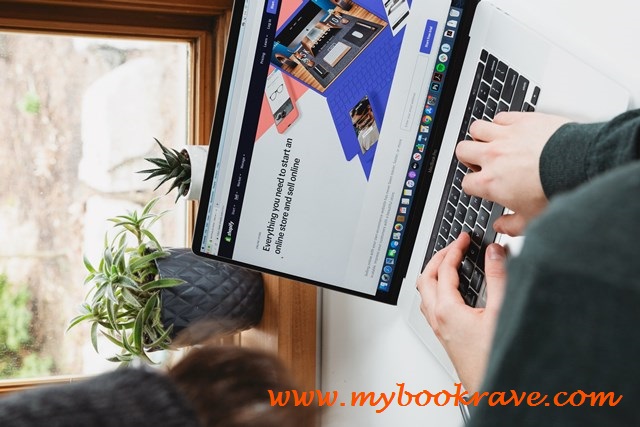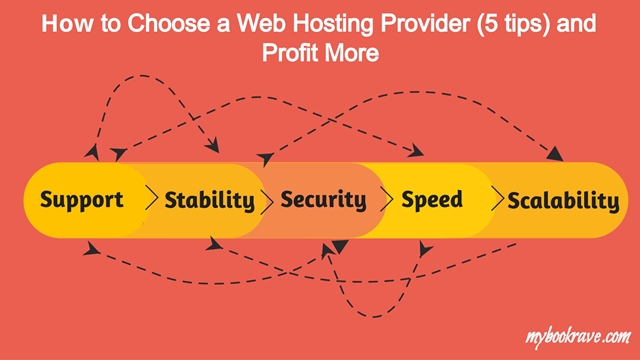Here, let us explore, how to start an eCommerce online shop (why) and make profit?
The number of average monthly visits to global retail e-commerce websites is 21.96 billion.
Global online eCommerce shopper’s conversion rate is 2.58% .
This means for every 100 people who visit your online site or store 2 and more people might purchase or make an order.
Note: If you want to read the blog on the go, you can download the full version of this blog below.
Table of Content
- Why you should start an e-Commerce or online shop (store)
- What is e-Commerce and e-Commerce history?
- What are the types of e-Commerce business models?
- Why as a blogger you should start ecommerce website or online shop?
- How to start an e-Commerce Online Shop?
- What are some e-Commerce website builders or platforms to start an online store?
- 8 Factors to consider while choosing an ecommerce website builder or platform
- What are the benefits of opening an e-Commerce website?
- What to consider before opening an e-commerce website?
- Final Thoughts
Disclosure: Please note that some of my links below are affiliated links. That is I may earn commission, at no additional cost to you on any purchases you’ve decided to make through these links. And, it helps me in running my blog (cost) at the same time bring in valuable insights to readers like you to decide on your purchases.
Please note that I only recommend those products either I am using personally or researched and because I believe that these products might help you improve your life or business.
How to start an eCommerce online shop (why) and make Profit?
So you have a blog. It is booming (making profit). You are now an online influencer (Content Marketer).
Now what?
If you have zeal, enthusiasm and growth mindset you can open online business (shop or services).
How? By leveraging and capitalizing on you’re already built brand.
Starting ecommerce site has never been easier than right now.
Most of the web hosting companies provides ecommerce designs and themes along with your regular blogging themes. For example: WordPress WooCommerce App.
Moreover, these e-commerce website builders help you through providing professional consulting for a small charge for your ecommerce website to up and running.
With blog or without a blog you can start an eCommerce business (online shop) website.
If you are planning to start a blog or business you can head over here on how to start a blog in 6 easy steps.
You can also watch a short video here on how to start a blog.
Now, let us see why eCommerce and the power of eCommerce?
Why You Should Start an e-commerce or Online Shop?
Some Statistics about eCommerce
According to Digital Commerce 360
In 2020 of all the total retail sales in U.S market 21.3% was spent on online purchases.
In 2020 consumers spent online with U.S. merchants $861.12 billion.
A mindboggling 44.0% increase year over year (YOY). That’s increase from 15.8% in 2019 and 14.3% in 2018.
According to Statista data that is available on the public domain
Retail e-commerce sales (products or services) worldwide from 2014 to 2024 increased from $1336 to $6388 (estimated) sales in billion dollars.
These numbers include products or services ordered using the internet via any device, regardless of the method of payment or fulfillment.
In 2020, retail e-commerce sales worldwide amounted to 4.28 trillion US dollars and e-retail revenues are projected to grow to 5.4 trillion US dollars in 2022.
In 2021, over 2.14 billion people worldwide are expected to buy goods and services online.
This is a surge from 1.66 billion global digital buyers in 2016. This is approximately more than 25% of the total population.
The Low Barrier Entry to eCommerce
Across the world, ecommerce is a thriving business for both local and international businesses.
The recent increase in internet penetration and users in countries like India is set to take e-commerce activity to a whole new level.
From international, local and to hyper-local, online business is going to increase leaps and bounds.
If you are starting a blog or already a blogger and influencer (content marketer) and entrepreneur with a unique niche it is high time that you take your business online.
Additionally, for new entrants the low market entry barrier also makes it even more enticing to start an ecommerce site.
Based on your product/services, you can choose the right combination.
For example,
- It can be a blog (content based marketing) with online shop or services or
- Standalone online shop or business or
- Online-offline hybrid model (a combination of physical stores (brick and mortar stores) and online shop).
eCommerce has completely changed the way we live. Earlier, eCommerce was just one of the options from many options available.
However, today eCommerce has become necessary (required) shopping option for consumers.
In 2020 as a consumer my experience was I never once stepped out my house to buy something. Circumstances (COVID -19) have changed the way we shop and live.
Moreover, the price, the convenience, the ability to research and compare the products has never been easier than ever now with eCommerce.
This tells how eCommerce has become an indispensable ingredient, impacting on us in every wake and walk of our lives.
Furthermore, let us understand what is e-commerce and little bit of e-commerce timelines.

What is e-Commerce and e-Commerce history?
Today, we all know what eCommerce is. However, let me just define what is eCommerce and to understand more let us see little bit of history about eCommerce.
What is eCommerce?
Electronic commerce or e-commerce or eCommerce is a business model that lets businesses and individuals to buy and sell things (Goods or Services) over the internet through a protected connection to fulfill the transactions.
In other terms, ecommerce uses the internet to carry out commercial transactions between businesses and individuals.
According to Merriam-Webster in simple words, commerce conducted via the internet.
Who invented eCommerce?
In 1979 Michael Aldrich invented online shopping to enable online transactions processing between consumers and businesses or between one business and other.
When and where did the first eCommerce site started?
Let us see some important time lines in ecommerce history (1990-2000)
In 1982 the world’s first ecommerce site was launched by Boston Computer Exchange. The business model was to serve as an online market for people who are interested to sell their used computers.
In 1992 (after nearly a decade) Book Stacks unlimited launched its first online book market place.
Later in 1995 Amazon launched as an ecommerce platform for books.
In 1999 Alibaba launched an online market place with more than 25 million in funding.
The period from 1990-2000 saw the rise of multiple e-commerce sites
If you are further interested in timeline and history of ecommerce you can head over here.
The rising popularity and capability of the internet became the ultimate fuel for its growth.
It also redefined the aspects of customer experience, payment methods, supply chain, etc.
To understand better, let us see further on the types of ecommerce business models.
What are the types of eCommerce business models?
The traditional ecommerce business models are based on the approach of their business transactions.
- Business to Business (B2B)
- Business to Consumers (B2C)
- Direct to Consumers (D2C)
- Business to Government (B2G)
- Consumer to Consumers (C2C)
- Consumer to Business (C2B)
Based on these there are many ecommerce businesses that have innovated themselves and evolved into new business models.
Business To Business (B2B)
B2B is the most common type of e-commerce. Here the transaction of goods or services happens between two business entities.
It can be for raw materials as well as finished goods or services.
Example, transactions made between manufacturers and retailers.
According to Forrester forecast USA B2B e-commerce will reach 1.8 trillion and account for 17% of all B2B sales in the USA by 2023.
Example: ResMed, Clarion Safety Systems, Bizbey (a global B2B platform that facilitates global trade with various goods and services)
Business To Consumer (B2C)
B2C is the most popular and most common category of ecommerce.
Here the transaction of goods or services happens between business and consumers.
Example: Amazon is one of the biggest B2C e-retailers in the world, serving goods and services in almost all continents.
In 2020, retail e-commerce sales worldwide amounted to 4.28 trillion US dollars and e-retail revenues are projected to grow to 5.4 trillion US dollars in 2022.
Direct To Consumer (D2C)
D2C is where brands sell directly to their end customers, by passing the third-party retailers, wholesalers or any other middlemen.
Most of the manufacturers have their own online shop and at the same time sell their products on other ecommerce online sites.
Warby Parker, Nanit, HIMS, Chubbies, and Dollar Shave Club are some successful D2C companies.
Business To Government (B2G)
B2G is a business model, where a firm acts as a supplier of various products and services to federal, state or local agencies.
These can be from a range of products such as a bulk supply of equipment, providing IT support services, sometimes as big as Boeing (helicopters), missile defense systems to the department of defense DOD. Etc.
Example: OpenGov is a technology company that offers cloud-based software for public sector budgeting, accounting, citizen services, and financial management. OpenGov serves over 1,000 cities, counties, and state agencies across 49 states.
Consumer To Consumer (C2C)
C2C is a business model where customers transact with each other on an online platform using third party website or portal.
Example: Craigslist, Etsy, eBay. eBay is a major C2C platforms that offers product exchange between two consumers. They operate both in an online auction method and an online portal for consumers to transact with each other.
Consumer To Business (C2B)
C2B is a business model, where individual professionals (freelancers) provide services to companies and create value for businesses using third party website or portal.
Example: Upwork, Toptal. These provide a freelancing platform for businesses and individual professionals (freelancers) like software engineers, designers, and finance experts etc. to connect in order to conduct business/services.
Moreover, according to Brent Walker (vice president and CMO at C2B Solutions) C2B can also mean that a business brings consumer insights and consumer-centric solutions to another business as its primary service or value-added offering”
Now, let us deep dive into why a blogger or influencer should start an ecommerce online shop.

Why as a Blogger You Should Start eCommerce Website or Online Shop?
As a blogger, influencer (content marketer) and as an affiliate marketer you are offering services at the same time making profit.
So let us see as a blogger and influencer what you have already on your side.
As a blogger and influencer you can capitalize on the assets you already have.
The 6 assets that you have as a blogger and online influencer (Content Marketer)
- Your popular domain name
- Your email list or subscribers
- You are an established Affiliate marketer (you’ve already built trust (Good will) with your audience)
- You’re already built a personnel brand as an expert
- The large amount of web traffic that you are able to drive to your website with different marketing channels (email marketing, Social media marketing, through SEO, Content creation)
- As a blogger you’re earning (making profits) that means you might have a capacity now to comfortably spend little more money on starting an ecommerce website.
Having all these doesn’t mean opening an ecommerce website is like easy breezy one.
Like any other business this is also attached with risk. The time you have to spend. And the money you have to invest.
Before diving into take into consideration these three factors risk, time and amount.
However, definitely, having the above 6 assets as a blogger and influencer can help you to start an ecommerce website or online shop.

How to start an eCommerce Online Shop?
If you are a registered blogger and earning income and paying taxes
As an extension of your blog you can start an ecommerce site using online store builders with the same domain name.
If you are just starting
Follow these 6 steps to open an eCommerce website
- Take into consideration the budget you have or you can spend
- Choose your niche (what products to sell)
- Strategize on your packaging and shipping (Drop shipping or holding your own products)
- Choose a domain name and purchase one
- Then, create a website with an online store builder or eCommerce builder platform
- Register a company on your name and get a sales tax ID
What are Some eCommerce Website Builders or Platforms to Start an Online Shop?
You have multiple ecommerce website builders or platform providers out there where you can host or start your ecommerce online shop
6 best eCommerce website builder platforms to start an online store
- WooCommerce
- Shopify
- AmeriCommerce
- BigCommerce
- Wix
- Weebly
Each ecommerce website builders or platforms have their own unique differentiation factors.
8 Factors to Consider while Choosing an eCommerce Website Builder or Platform
While choosing a eCommerce website builders few factors that needs to keep in mind or look for based on your product and services are
- My first choice would be ease of use, how easily you can set up a business and start it and also the theme you select is how user friendly it is for the end user. Is the design theme all devices friendly? (example: on mobile phones, tablets, desktops and laptops)
- The second I would prefer is integrations with the third party tools as your business grows
- The third factor is security. How much security for your website at the same time for the end users
- The fourth I would go for is support of multiple payment methods, choice of payment modes for the flexibility for the users (Merchant processors, PayPal, Stripe etc..)
- The fifth I would look for its speed, the site loading capacity
- The sixth one is stability of the site that is uptime.
- The seventh one is about scalability. Is there varied product diversification available to choose from as your business grows?
- Then eighth one is budget. How much you can spend?
All these are important factors to consider. Not in any particular order.
However, as per your convenience, your budget, according to your blog or business and type of business you have to choose or weight in the factors.

What are the Benefits of Opening an eCommerce Website?
Opening an e-commerce business can be your ultimate gateway to business growth. It removes your geographical barriers and widens your customer segments.
The major benefits of opening an e-commerce site when you have an already thriving blog or as an influencer are
Customer base expansion:
It certainly can widen your customer base. Expand your foot print. You can sell your product anywhere in the world without any geographical barriers.
Higher Revenue:
For an already thriving blog an online shop can increase the visibility and at the same the site may earn more customers vice versa (from blog and online shop) and generate more revenue.
Earn while you sleep:
Since online stores operates 365 days/24 hours globally. You can earn while your sleep increasing your earning potential.
Manage your business from anywhere
Having online shop can be flexible managing from anywhere in the world
What to Consider Before Opening an eCommerce Website?
There is millions of e-commerce websites live on the internet.
There are 12 million – 22 million eCommerce sites across the entire globe. And, the numbers are only rising day by day.
However, according to WPform only less than 1M sites make more than $1000/year. So there is tons of room for growth in 2021.
Here are some things that need to be considered before you venture into an ecommerce.
Although opening an e-commerce site may be a smart move, there are a few things to consider.
1. It is an extremely competitive industry.
2. You must develop your unique value proposition to stand out from the crowd.
3. Proper market research is an absolute must.
4. Invest time in planning your business model. You need to consider things like your investment model, sources of revenue, and your target audience.
5. Managing and deciding on options like inventory management, shipping, drop shipping, invoices and taxes etc.
6. Effective marketing, both digital and content marketing, is vital to the success of your e-commerce business. Marketing plays a key role in driving more web traffic to your website.
That said as any business, starting an eCommerce online shop comes with its own set of pros, cons and challenges.

Final Thoughts
We have seen the statistics how ecommerce market will be the only market that will drive the future businesses.
Moreover, with the rising popularity of e-commerce and taking into the present circumstances into consideration now might be the right time to open your e-commerce business.
While capitalizing and leveraging on the strengths as a blogger and influencer (content marketer).
At the same time considering the benefits of opening an ecommerce shop. Such as
- No geographical limitations
- Increased customer reach
- 24/7 operations
- Lower costs
- Ability to run the business from anywhere
If you are planning to start a blog or business you can head over here on how to start a blog in 6 easy steps.
You can also watch a short video here on how to start a blog.






































































































































